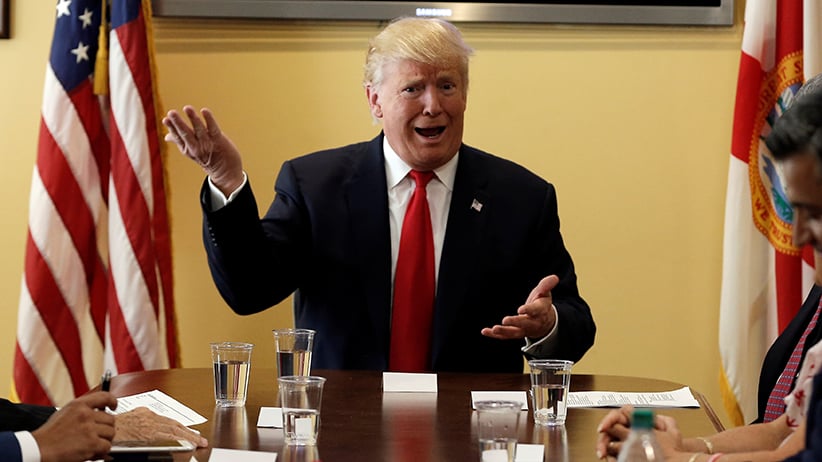And the biggest economic uncertainty for Canada under Trump is…
We asked economists and policy experts for what they think will be the biggest sources of economic uncertainty for Canada
U.S. Republican presidential nominee Donald Trump meets with local small business leaders before a campaign rally in West Palm Beach, Florida, U.S., October 13, 2016. (Mike Segar/Reuters)
Share

Considering Donald Trump and many of his cabinet members have drastically different views on many economic policy issues—everything from free trade to Russian sanctions to immigration, not to mention the fact that Trump has repeatedly contradicted himself—no one anywhere is quite sure what to expect.
Canada, in particular, has a lot to be concerned about, given our proximity and deep trading ties to the U.S. So we asked nine Canadian economists and public policy experts to answer one question: “What is the biggest economic uncertainty facing Canada under Trump?”
MORE: Why Canada’s economy has plenty to fear from Trump
Armine Yalnizyan, senior economist at the Canadian Centre for Policy Alternatives. Twitter: @ArmineYalnizyan
 “It’s hard to pick just one uncertainty when it comes to anticipating the impact of the Trump presidency on the Canadian economy. The uncertainties lie along three dimensions: timing, direction of change, and magnitude of change. Trump’s arrival in Washington alters both the tone and range of what can happen politically and culturally, is likely to exacerbate inequality, and represents an about-face on the resolve to address the most existential issue of our time, climate change. All these factors shape economics. Trump’s trade policies and his policies’ impacts on domestic purchasing power in the U.S. could slow Canada’s economic growth. Trumpist trade may—or may not—dramatically affect supply chains in auto and steel, and decrease Canadian market share of softwood lumber, oil, hogs and beef, and manufactured goods. Policies on education, taxation, labour and women in the era of Trump will shape purchasing power as much as, if not more, than the mere number of jobs created. I’ll be closely watching wage growth, labour force participation by age, and changes in income inequality.”
“It’s hard to pick just one uncertainty when it comes to anticipating the impact of the Trump presidency on the Canadian economy. The uncertainties lie along three dimensions: timing, direction of change, and magnitude of change. Trump’s arrival in Washington alters both the tone and range of what can happen politically and culturally, is likely to exacerbate inequality, and represents an about-face on the resolve to address the most existential issue of our time, climate change. All these factors shape economics. Trump’s trade policies and his policies’ impacts on domestic purchasing power in the U.S. could slow Canada’s economic growth. Trumpist trade may—or may not—dramatically affect supply chains in auto and steel, and decrease Canadian market share of softwood lumber, oil, hogs and beef, and manufactured goods. Policies on education, taxation, labour and women in the era of Trump will shape purchasing power as much as, if not more, than the mere number of jobs created. I’ll be closely watching wage growth, labour force participation by age, and changes in income inequality.”
Dawn Desjardins, deputy chief economist, RBC Economic Research.
 “The implementation of import taxes by the new administration would present one of the greatest risks to Canada’s economy in the near term. About three-quarters of Canadian exports go to the United States, a growing proportion of which are intermediate inputs into the production of U.S. goods. The levying of a tariff that results in sharply higher costs of Canadian exports would translate into a significant boost to prices for finished goods and potentially result in the dissolution of these trading relationships. Either result risks crippling production in many important industries on both sides of the border, leading to slower economic growth not only in Canada but in the U.S. as well.”
“The implementation of import taxes by the new administration would present one of the greatest risks to Canada’s economy in the near term. About three-quarters of Canadian exports go to the United States, a growing proportion of which are intermediate inputs into the production of U.S. goods. The levying of a tariff that results in sharply higher costs of Canadian exports would translate into a significant boost to prices for finished goods and potentially result in the dissolution of these trading relationships. Either result risks crippling production in many important industries on both sides of the border, leading to slower economic growth not only in Canada but in the U.S. as well.”
Jennifer Robson, assistant professor of public policy and political management, Carleton University’s Kroeger College. Twitter: @JenniferRobson8
 “I’m going to be unoriginal and suggest that in the short-term, a big (not sure if it’s the biggest or “bigly-est”) risk could be a much thicker border with the U.S. Since 2011, Canada and the U.S. have been running the Beyond the Border Initiative to reduce barriers to cross-border flow of goods and people. This let Canada start a conversation on border fees—how many are in place, on what, and what are the economic impacts. Quick summary: there are many; the U.S. already charges more than Canada; and, the impacts on output and exports are much worse for Canada.
“I’m going to be unoriginal and suggest that in the short-term, a big (not sure if it’s the biggest or “bigly-est”) risk could be a much thicker border with the U.S. Since 2011, Canada and the U.S. have been running the Beyond the Border Initiative to reduce barriers to cross-border flow of goods and people. This let Canada start a conversation on border fees—how many are in place, on what, and what are the economic impacts. Quick summary: there are many; the U.S. already charges more than Canada; and, the impacts on output and exports are much worse for Canada.
Trump has telegraphed a pretty strong interest in border taxes. Politically, this would be a pretty easy and quick win. Canada and the U.S. will come to some kind of agreement on this issue. Some new equilibrium will emerge. But whatever that deal looks like, I wonder how much the work to get that deal might derail other plans, initiatives we were told are essential to a more productive and inclusive economy for the long-term.”
Sherry Cooper, chief economist, Dominion Lending Centres. Twitter: @DrSherryCooper
 “Much hand-wringing in Canada, as elsewhere, is accompanying the ascension of Donald Trump to the presidency, and for good reason. Most disturbing for Canada’s economy is the potential change in U.S. trade policy, which is threatened to include border tariffs and the American exit from NAFTA. Most of the U.S. rhetoric has been directed toward Mexico, but Canada could well be side-swiped in the process. In addition, the global economy would no doubt be damaged by retaliatory trade wars between China and the U.S., none of which is good news. Proposed cuts in U.S. corporate and personal taxes would damage Canada’s relative competitive position, particularly given the recent rise in the Canadian dollar.
“Much hand-wringing in Canada, as elsewhere, is accompanying the ascension of Donald Trump to the presidency, and for good reason. Most disturbing for Canada’s economy is the potential change in U.S. trade policy, which is threatened to include border tariffs and the American exit from NAFTA. Most of the U.S. rhetoric has been directed toward Mexico, but Canada could well be side-swiped in the process. In addition, the global economy would no doubt be damaged by retaliatory trade wars between China and the U.S., none of which is good news. Proposed cuts in U.S. corporate and personal taxes would damage Canada’s relative competitive position, particularly given the recent rise in the Canadian dollar.
Nevertheless, to the extent that Trumpian fiscal stimulus, infrastructure spending and deregulation boosts the American economy, Canada could well benefit. Our economies are closely linked and strong U.S. demand has positive spillover effects, increasing resource prices and boosting U.S. demand for Canadian goods and services. An American building boom would trigger demand for forest products, copper and other resources and Canadian companies in the transportation sector could see a surge in demand.”
Meredith Lilly, associate professor and Simon Reisman Chair in International Affairs at Carleton University. Twitter: @LillyResearch
 “If the latest reports about the U.S.’s plans for NAFTA are correct—addressing rules of origin and dispute settlement provisions—the consequences for the Canadian economy could be serious but manageable. Since a wholesale negotiation of NAFTA would be prolonged and would offer no quick wins to Trump or the U.S. economy, it would make sense for the new U.S. administration to approach NAFTA with a scalpel rather than a hammer.
“If the latest reports about the U.S.’s plans for NAFTA are correct—addressing rules of origin and dispute settlement provisions—the consequences for the Canadian economy could be serious but manageable. Since a wholesale negotiation of NAFTA would be prolonged and would offer no quick wins to Trump or the U.S. economy, it would make sense for the new U.S. administration to approach NAFTA with a scalpel rather than a hammer.
While Canada should expect its trade relationship with the U.S. to remain strong and productive under Trump, there are likely to be other more, immediate challenges to the Canadian economy. Trump’s plans for U.S. corporate tax reform could pass swiftly through the Republican-controlled Congress, with no need for messy negotiations with other countries. Under Trump’s proposed 15 per cent corporate tax rate, Canada would immediately become a less attractive place to own and operate a business. American companies operating in Canada will have new incentives to move home, foreign investors from outside North America may opt to set up in the U.S. over Canada, and even Canadian businesses may see greener grass on the American side of the border. Canada will need to keep a close eye on any U.S. reforms and be ready to adjust.”
Tammy Schirle, associate professor of economics, Wilfrid Laurier University. Twitter: @tammyschirle
 “I am most immediately concerned about jobs in industries seriously affected by NAFTA, such as Ontario’s auto industry, which has been struggling for many years. Automakers organize themselves across borders: parts made in several countries come together for assembly in Canada or the U.S. in ways that make companies money, and keep the price of a car relatively low. Any trade barriers that make building cars more difficult or expensive will result in more expensive cars, fewer cars built, and probably fewer jobs. This is where the potential for reopening NAFTA matters.
“I am most immediately concerned about jobs in industries seriously affected by NAFTA, such as Ontario’s auto industry, which has been struggling for many years. Automakers organize themselves across borders: parts made in several countries come together for assembly in Canada or the U.S. in ways that make companies money, and keep the price of a car relatively low. Any trade barriers that make building cars more difficult or expensive will result in more expensive cars, fewer cars built, and probably fewer jobs. This is where the potential for reopening NAFTA matters.
I imagine most companies, however, aren’t going to sit idly by waiting to see how those negotiations work out. They will start right now, finding ways to reduce their own uncertainty—perhaps making greater efforts to rely less on workers in routine jobs and move toward greater use of technology in their production process. Some companies will simply avoid making new large investments until their long-term business environment is clearer. In any case, I’d pay attention to jobs in these sectors. I wasn’t very optimistic regarding Ontario’s manufacturing outlook before, I’m much more concerned now.”
Frances Donald, senior economist, Manulife Asset Management. Twitter: @francesdonald
 “The elephant in the Canadian room is without a doubt the future of trade with the United States: trade makes up one-third of the Canadian economy, and three-quarters of that trade heads straight to our neighbours to the south. The challenge is that there is a wide range of potential future outcomes for this trading relationship under the new U.S. administration: everything from renegotiating official trade agreements like NAFTA to implementing sizable border taxes could affect only a few, some, or all of Canada’s major industries. The timelines for any potential policy changes are also unclear.
“The elephant in the Canadian room is without a doubt the future of trade with the United States: trade makes up one-third of the Canadian economy, and three-quarters of that trade heads straight to our neighbours to the south. The challenge is that there is a wide range of potential future outcomes for this trading relationship under the new U.S. administration: everything from renegotiating official trade agreements like NAFTA to implementing sizable border taxes could affect only a few, some, or all of Canada’s major industries. The timelines for any potential policy changes are also unclear.
In the near-term, however, the focus should be on how Canadian behaviour may change in this wash of uncertainty. With such a cloudy crystal ball, will Canadian companies move ahead with investment plans? Will Canadian workers in export-reliant jobs feel confident making big ticket purchases? Will Canadian policy-makers act pre-emptively against downside risks to trade or will they wait to see actual policy announcements before making adjustments? It’s possible (though not probable) that very little changes between Canadian and U.S. trade over the next four years, but a current and ongoing lack of visibility into the future alone may be enough to alter the course of the Canadian economy.”
Laura Dawson, director of the Canada Institute at the Wilson Center. Twitter: @DawsonCanada
 “The biggest economic uncertainty for Canada under President Trump is the effect of unintended consequences. The President has identified the repatriation of manufacturing jobs, punishments for currency manipulators, and spending on infrastructure as priorities. There have been no statements directly targeting Canada but collateral damage is possible as he carries out these goals through, for example, higher import tariffs, scrutiny of Canadian monetary policy, and “Buy America” restrictions on infrastructure. But, concerns about possible repercussions need to be tempered with the reality of how many new tasks the President can accomplish across the many domestic and international policy areas he has identified and resistance from Congress on trade matters that reach into their traditional areas of authority. What is less uncertain but more potentially damaging for Canada is the widening gap in carbon costs between the United States and Canada. While carbon reduction is an important environmental goal for all states, the new President shows no signs of supporting higher U.S. carbon prices, thus, as Canadian prices go up, manufacturers and agri-businesses may move to the U.S. because of the relatively lower costs of doing business there.”
“The biggest economic uncertainty for Canada under President Trump is the effect of unintended consequences. The President has identified the repatriation of manufacturing jobs, punishments for currency manipulators, and spending on infrastructure as priorities. There have been no statements directly targeting Canada but collateral damage is possible as he carries out these goals through, for example, higher import tariffs, scrutiny of Canadian monetary policy, and “Buy America” restrictions on infrastructure. But, concerns about possible repercussions need to be tempered with the reality of how many new tasks the President can accomplish across the many domestic and international policy areas he has identified and resistance from Congress on trade matters that reach into their traditional areas of authority. What is less uncertain but more potentially damaging for Canada is the widening gap in carbon costs between the United States and Canada. While carbon reduction is an important environmental goal for all states, the new President shows no signs of supporting higher U.S. carbon prices, thus, as Canadian prices go up, manufacturers and agri-businesses may move to the U.S. because of the relatively lower costs of doing business there.”
Stephanie Carvin, assistant professor, Norman Paterson School of International Affairs, Carleton University. Twitter: @StephanieCarvin
 “Canada’s success depends on global order and stability, and the world has done a pretty good job of that since 1945 (for the most part). With no military conflict or insecurity, plus a stable international rule of law, Canada could focus on building the institutions that facilitate trade with our partners. And let’s not discount the fact that when other countries feel safe and confident in the global order, they too can focus on middle-class growth—which often includes buying goods and services that Canada produces. But then comes President Trump and it is hard to discern exactly what his policies will be.
“Canada’s success depends on global order and stability, and the world has done a pretty good job of that since 1945 (for the most part). With no military conflict or insecurity, plus a stable international rule of law, Canada could focus on building the institutions that facilitate trade with our partners. And let’s not discount the fact that when other countries feel safe and confident in the global order, they too can focus on middle-class growth—which often includes buying goods and services that Canada produces. But then comes President Trump and it is hard to discern exactly what his policies will be.
Since the Second World War, powerful and rising countries acted on the principle that order not only prevented nuclear war, but served as a benefit for all, creating the conditions of prosperity. America traditionally served as a guarantor of this liberal order, but now it appears that Trump isn’t willing to pay the costs of doing so (even if the U.S. has disproportionally benefited from its leadership role). Trump’s views appear to be that the U.S. will prosper from disrupting the current order entirely. Combined with a mischievous Russia, Brexit Britain, and rising China eager to assert its control over the South China Sea, we are now faced with an international system where disruption—and not the stability Canada has long depended upon—may be the new normal. It’s all “unpresidented.”